The different types of yoga: find the right yoga style for you
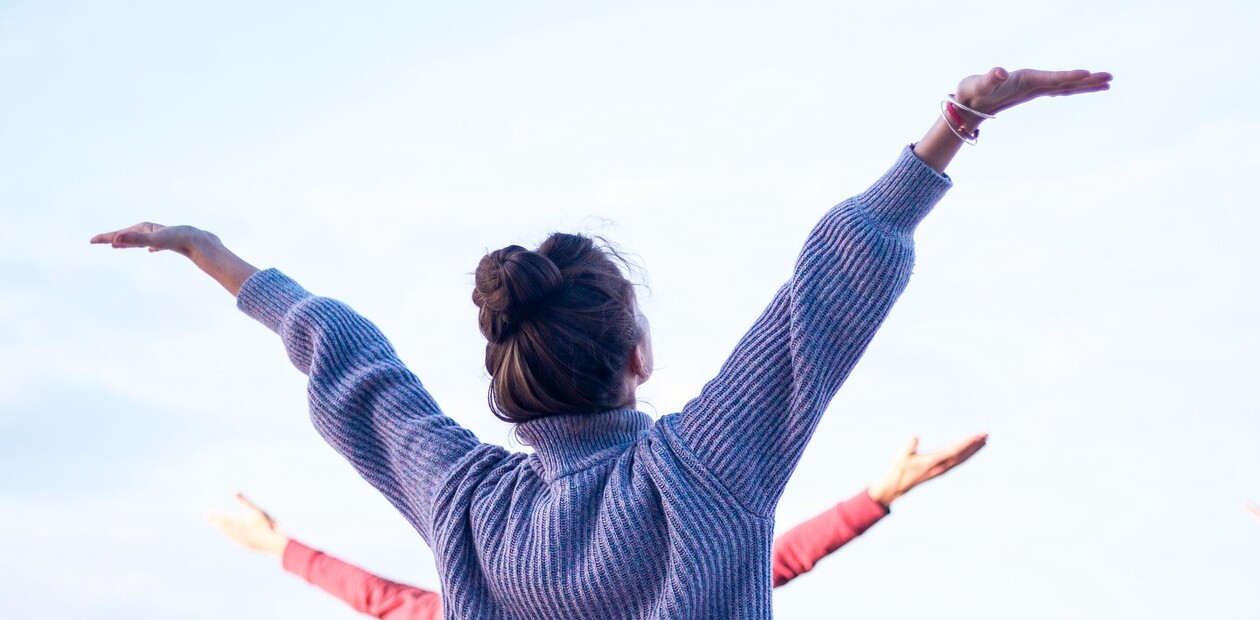
- Introduction
- The variety of types of yoga and their comprehensive benefits
- The history of yoga and its development
- The origin of yoga in India
- The eight limbs of yoga according to Patanjali
- Development of different yoga styles
- Yoga today
- Fancy a yoga retreat by the sea?
- Overview of the most important types of yoga
- Hatha Yoga
- Iyengar Yoga
- Ashtanga Yoga
- Digression on the origins of Ashtanga Yoga
- 30 minutes Ashtanga from the first series
- Vinyasa Yoga (Vinyasa Flow)
- Power Yoga
- Interview with Bryan Kest - Founder of Power Yoga
- Kundalini Yoga
- Sivananda Yoga
- Niche and special types of yoga
- Yin Yoga
- Jivamukti Yoga
- Bikram Yoga and Hot Yoga
- Acro Yoga
- Entry position "Front Bird" (flyer)
- Anusara Yoga
- Yoga Nidra
- Karma Yoga
- Prenatal Yoga
- Restorative Yoga
- Aerial Yoga
- Modern trends in yoga
- Face Yoga
- Yoga for seniors
- SUP Yoga (Stand-Up Paddle Yoga)
- How do I find the right yoga style for me?
- How to find your yoga style
- The health benefits of yoga
- Advantages
- Yoga and the modern way of life
- How yoga fits into your everyday life
- Small yoga lexicon
- Lexicon
- Conclusion: the types of yoga
- Fancy yoga by the sea?

Jana is responsible for the website and blog at A-Frame. As a digital nomad and surf lover, she can work from anywhere in the world. She has currently opted for the Allgäu and El Palmar. For the Allgäu because of the love and for El Palmar because of the waves.
Introduction
Yoga has long been more than just a fitness trend - it is a millennia-old practice that brings body, mind and soul into harmony. But many people don't know this: Not all yoga is the same. There are numerous types of yoga that differ in their approach, intensity and goals. Whether you are looking for more physical flexibility, mental calm or spiritual growth, there is a suitable type of yoga for every life situation and fitness level.
From the powerful movements of Vinyasa Yoga to the gentle and meditative techniques of Yin Yoga, the variety of yoga styles offers numerous options to meet your own physical and mental needs. Especially in our modern, stress-filled world, the different types of yoga offer valuable approaches to finding inner balance.
In this comprehensive guide, you will learn all about the most popular yoga styles and their special features. Whether you are a beginner or already have experience - we will help you find the perfect yoga style for you.
Dive into the fascinating world of yoga styles and discover which method suits you best to strengthen your physical fitness and promote your inner balance.
The variety of types of yoga and their comprehensive benefits
The different types of yoga offer a wide range of techniques that meet both the physical and mental needs of people of all ages and fitness levels. This diversity is due to the different cultural influences and developments that yoga has undergone over time. From traditional Hatha Yoga to modern styles such as Power Yoga or Aerial Yoga, there are countless ways to practise yoga.
The benefits of these numerous yoga styles are manifold: physically, yoga promotes flexibility, strengthens the muscles and improves balance. At the same time, it contributes to mental clarity, reduces stress and promotes inner peace. Yoga styles such as Restorative Yoga and Yin Yoga are ideal for those seeking relaxation and regeneration, while Vinyasa Yoga or Ashtanga Yoga offer more dynamic, powerful movements that support cardiovascular health.
This flexibility makes yoga attractive to different target groups. Beginners can build a solid foundation through gentler styles such as Hatha Yoga, while advanced practitioners can challenge themselves physically in more demanding disciplines such as Ashtanga or Bikram Yoga. Sportspeople appreciate yoga for its ability to improve flexibility and prevent injuries, while people with health problems, such as back pain or stress, benefit from the healing properties of certain types of yoga.
All in all, the variety of types of yoga offers everyone a way to strengthen themselves physically and find mental serenity at the same time. No matter what goal you are pursuing - there is a suitable practice for you in the world of yoga
.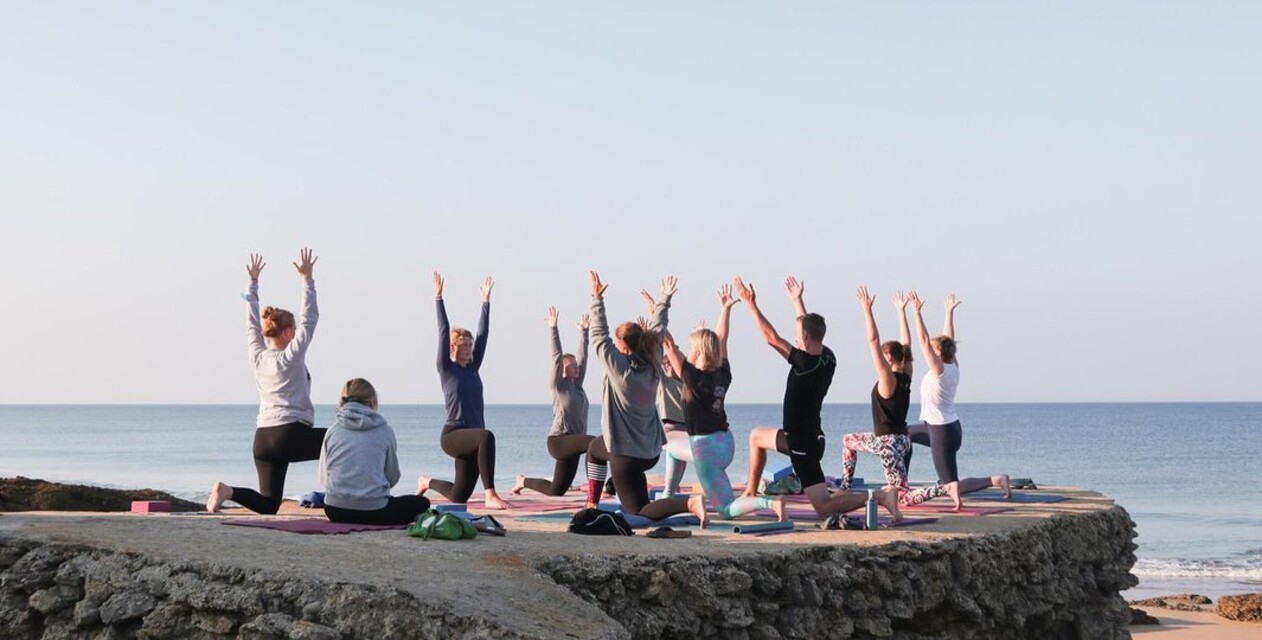
The history of yoga and its development
Yoga has its roots deep in Indian culture and dates back over 5,000 years. It originated as a spiritual practice that aimed to connect people with the divine and expand their consciousness. Yoga was originally part of the Vedic traditions and was mentioned in ancient texts such as the Vedas and the Upanishads, which described spiritual disciplines and meditations. Yoga was closely linked to the philosophy and spirituality of India.
The origin of yoga in India
The term "yoga" comes from Sanskrit and means "union" or "connection". In the earliest forms of yoga, the focus was on meditation, breath control and ethical principles. Particularly significant is the Yoga Sutra, a classic work by the sage Patanjali, which is considered the most important text of yoga. This work, which was written around 2,000 years ago, sets out the basic principles of yoga and describes the spiritual path in the form of the "eight limbs of yoga" (Ashtanga).
The eight limbs of yoga according to Patanjali
The eight limbs of yoga (also known as Ashtanga yoga) form the foundation for modern yoga practice and include both ethical and physical aspects:
Yama - Ethical disciplines (such as non-violence and truthfulness).
Niyama - Inner disciplines (such as purity and contentment).
Asana - Postures that prepare and strengthen the body.
Pranayama - Breath control and guidance to control the life energy (prana).
Pratyahara - Withdrawal of the senses from external distractions.
Dharana - Concentration on a single object or goal.
Dhyana - Meditation, the calm and steady abiding in thoughtlessness.
Samadhi - Complete union of body, mind and soul, the highest form of consciousness.
Development of different yoga styles
Over the centuries, yoga continued to develop and adapt to the respective cultural and social needs. From the 19th century in particular, yoga began to gain popularity in the West. Traditional styles such as Hatha Yoga (focused on physical exercises and breathing techniques) laid the foundation for many modern types of yoga.
In modern times, numerous new styles have been developed with different focuses - from spiritual practices such as Kundalini Yoga, to physically demanding forms such as Ashtanga Yoga and Bikram Yoga, to therapeutic approaches such as Restorative Yoga. These developments reflect the need to adapt yoga not only as a spiritual practice, but also as a means of promoting physical health and mental well-being.
Yoga today
The variety of types of yoga today is the result of this long development. While some styles concentrate on the spiritual and meditative aspects of yoga, others focus on physical fitness, stress management or healing. Yoga remains a dynamic practice that is constantly evolving and inspiring more and more people around the world.
We look forward to welcoming you to our surf camp for one of our wonderful yoga retreats or a spontaneous drop-in class. Take a look around our offer. A wide variety of yoga styles are represented in the retreats.
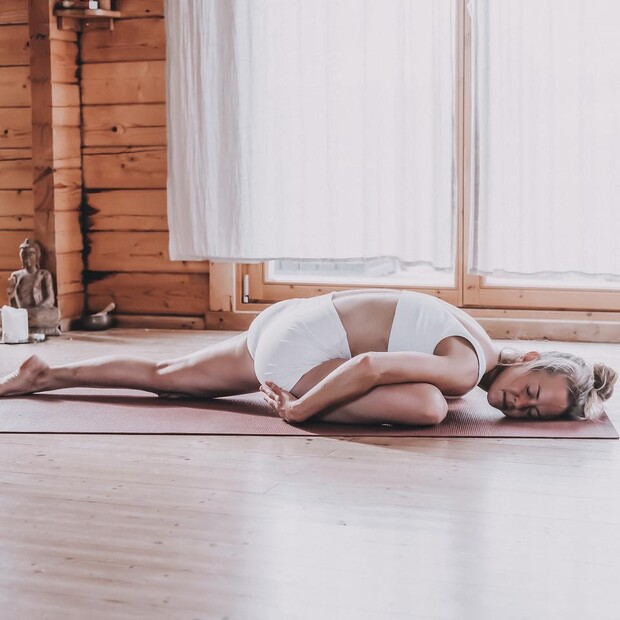
Fancy a yoga retreat by the sea?
If you fancy a yoga retreat now, take a look at our yoga retreats. You're sure to find something suitable. We teach in our beautiful yoga shala with a view of the Atlantic. With us, you can do yoga, learn to surf or combine the two. In addition to the yoga retreats, we also offer open yoga classes for spontaneous yogis. Maybe we'll see you in Spain soon!
Overview of the most important types of yoga
The world of yoga offers an impressive variety of styles that differ in their approach, intensity and goals. Here is an overview of the main types of yoga that are suitable for both beginners and advanced practitioners:
Hatha Yoga
The most widely practiced style in the West is hatha yoga.
Hatha yoga is a form of yoga in which the balance between body and mind is sought primarily through physical exercises, breathing exercises and meditation. In hatha yoga, the emphasis is on the body. This is nothing new for us at first, because in the West we associate yoga almost exclusively with physical exercises. However, yoga, with its many facets, has numerous other traditions that seek the path to unity in very different ways. Bhakti yoga, for example, aims to achieve unity through love and devotion to God, including through mantra chanting. In Raja Yoga, the yoga of mind control, one addresses the mind directly and practises by analyzing and controlling thoughts. Etc. Compared to other yoga styles, meditation in hatha yoga leads to a feeling of unity through doing, through "effort". Swatmarama, the author of the Hatha Yoga Pradipika, said: "If you are somehow confused by philosophies and world views and spiritual systems, then practise Hatha Yoga. You don't need to believe in anything, just do it, do it!"
Yoga as an experiential science
Yoga teacher and camp founder Kathrin finds:
"The various practices help you to become physically healthy, strong and pure, to concentrate and calm down mentally and, moreover, to recognize what you really are."
The forms of hatha yoga
Classical hatha yoga classes are calm and include strengthening and stretching elements. However, there are also variations of classic hatha yoga. All yoga that emphasizes the body is a form of hatha yoga, even if it does not always bear this name. For example, Iyengar yoga, Anusara yoga, etc.
Hatha yoga summarized:
Classical yoga style
Focus on the body
Holistic approach with pranayama & Meditation
Strengthening balance (physical and internal)
Strengthening the muscles and body
Improving flexibility
Developing inner peace, clarity and relaxation
Suitable for all

Iyengar Yoga
Iyengar yoga is a more modern form of hatha yoga, which is characterized by the precise execution of the asanas (physical exercises).
In class, the student receives detailed instructions on how the body should be aligned in each exercise. Yoga postures are performed consciously and held for longer, which allows the effect of the asanas to really unfold. The bones and joints are aligned in such a way that the muscles do not have to work unnecessarily. In addition to the physical stability and relaxation that this creates, it also increases body awareness. The connections in the body become more perceptible to the practitioner. One of these connections is from the feet and legs to the spine. It makes the work of the feet and legs in our spine perceptible. In Iyengar yoga, many standing postures are therefore practiced. The sequences are also put together according to focus areas and logically coordinated.
Aids
Another feature of Iyengar yoga is the use of aids. Blankets, blocks, straps, etc. are used to support students so that they can feel the effect of the exercise even when their own body is not yet able to do so. This applies to beginners, but also to those with physical limitations, illnesses or disabilities. The use of aids has become established in many other yoga styles, with blocks and straps now being a natural part of yoga equipment.
Yoga therapy
Iyengar yoga has also shaped yoga therapy with this approach, which takes into account the anatomy and functions of the body. In his well-known book "Light on Yoga", which contains a precise list of around 200 yoga asanas and is also known as the "yoga bible", you will find sequences for many different illnesses at the end.
His sequences for yoga during menstruation, pregnancy and menopause as well as energizing sequences are also well-known. Iyengar Yoga aims to make yoga accessible to everyone and has strongly influenced many areas of modern yoga.
B.K.S. Iyengar
B.K.S. Iyengar himself (the founder) was voted one of the 100 most influential people in the world by Times Magazine (USA), dubbed the "Michelangelo of Yoga" or "King of Yogis".
Nice to Know: Incidentally, B.K.S. Iyengar was a student of the famous Indian Krishnamacharya, who also taught Pattabi Jois, the founder of Ashtanga Yoga. Both continued his teachings in completely different ways.
Iyengar yoga summarized:
Modern hatha yoga
Precisely instructed classes
Development of body awareness
Logical structure according to Focus
Use of tools
Pranayama
Less spiritual
Emphasis on the body
90min. incl. initial meditation and final relaxation
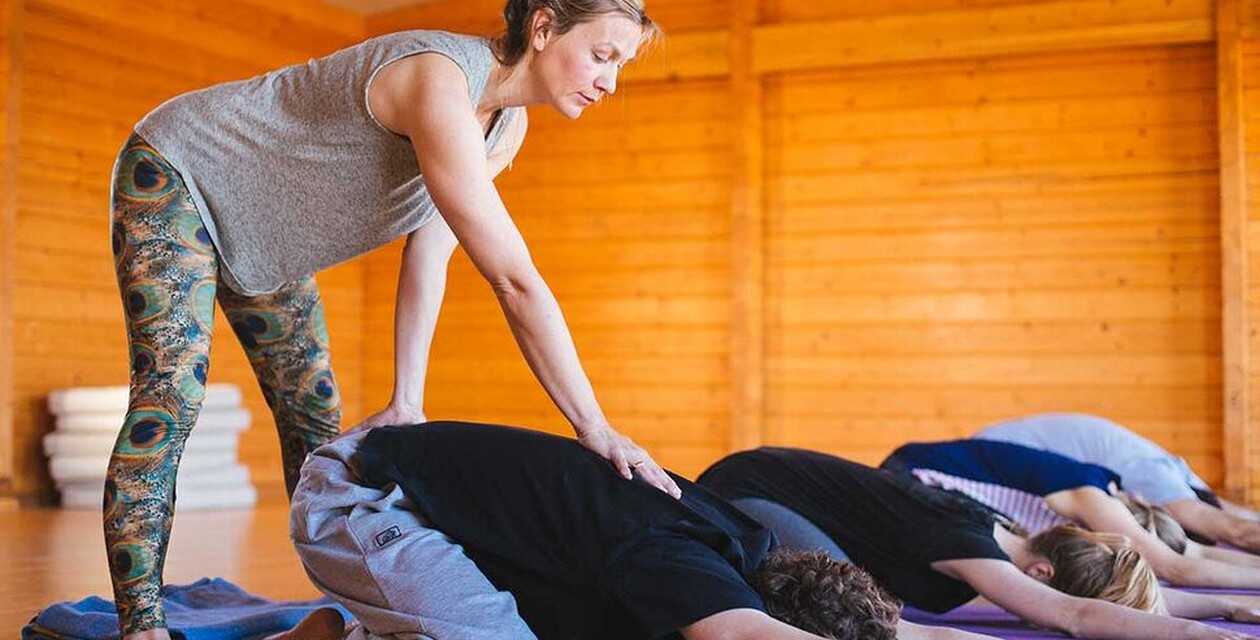
Ashtanga Yoga
Ashtanga yoga is a dynamic form of hatha yoga that has strongly influenced our western, modern yoga. The asanas (postures) are dynamically combined with breathing to form a so-called vinyasa. In addition to the continuous Ujjayi breath, the practice is characterized by energy locks (bandhas) and gaze focus (drishti).
In Ashtanga yoga, the asanas are practiced in a specific order, the so-called series. There are 6 series in total, although only a few very advanced students make it to the 6th series.
1st series (Primary Series): Yoga Chikitsa --> cleansing of the physical body, many forward bends
2nd Series (Intermediate Series) Nadi Shodana --> cleansing of the energy channels, many backbends
3rd to 6th Series (Advanced A, B, C).Series (Advanced A, B, C and D Series) --> Sthira Bhaga - The Sublime Calm
The Advanced Series are practiced by a small number of yogis and require mastery of the first two series. The first series is taught in regular classes.
Ashtanga yoga is taught in 2 different styles:
in a guided class; usually 90 minutes including final relaxation
in the Mysore style; everyone practices according to their individual skill level in their series, the teacher assists and corrects everyone individually
Anyone can practice. Young man can practice. Old man can practice. Very old man can practice. Man who is sick, he can practice. Man who doesn't have strength can practice. Except lazy people; lazy people can't practice yoga."
(Sri K. Pattabhi Jois)
Ashtanga yoga summarized:
Modern yoga style
Physically challenging and dynamic
Mantra at the beginning and end
Announcement of the exercises in Sanskrit
A fixed sequence is practiced
Suitable for: Anyone looking for a physical challenge embedded in tradition
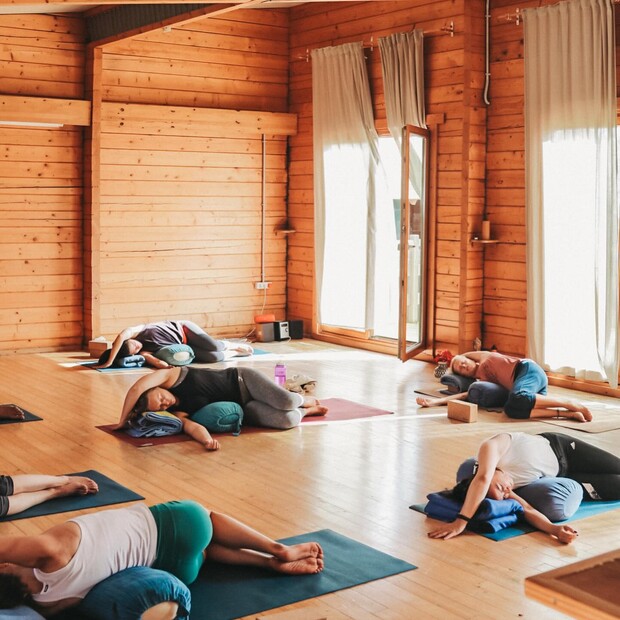
Digression on the origins of Ashtanga Yoga
Ashtanga yoga originated in the Indian city of Mysore. There was a maharaja there who kept himself fit and healthy with yoga. When the Maharaja met T. Krishnamacharya one day, a yoga school was even opened in the palace. On the one hand, to teach the royal family. On the other hand, a strenuous and dynamic sequence of asanas was developed to tame the impatient and impetuous boys at court. Two of Krishnamacharya's most famous students were BKS Iyengar and Pattabi Jois (who died a few years ago). Pattabi was one of the most influential figures in modern yoga, studying with Krishnamacharya for 25 years and eventually taking Ashtanga yoga around the world, as far as Australia and New York.
30 minutes Ashtanga from the first series
Vinyasa Yoga (Vinyasa Flow)
In contrast to classic Ashtanga yoga, Vinyasa yoga does not adhere to a specific sequence (series) of asanas. The flows are often put together according to a specific focus.
The individual exercises flow smoothly into one another (hence the nickname Vinyasa "flow"). Transitioning asanas therefore create a real flow in a vinyasa flow class. There are different difficult variations of the individual asanas for every yoga level, so that beginners and advanced practitioners alike can enjoy yoga.
Vinyasa yoga summarized
Modern yoga style
Dynamic
Combination of movement and breath flow
Yoga exercises flow smoothly into one another
Mainly variations of the sun salutation
Aim: Strengthening the muscles and concentration, releasing tension, balance
Final meditation helps to achieve inner peace
Suitable for: Suitable for yoga beginners and advanced practitioners
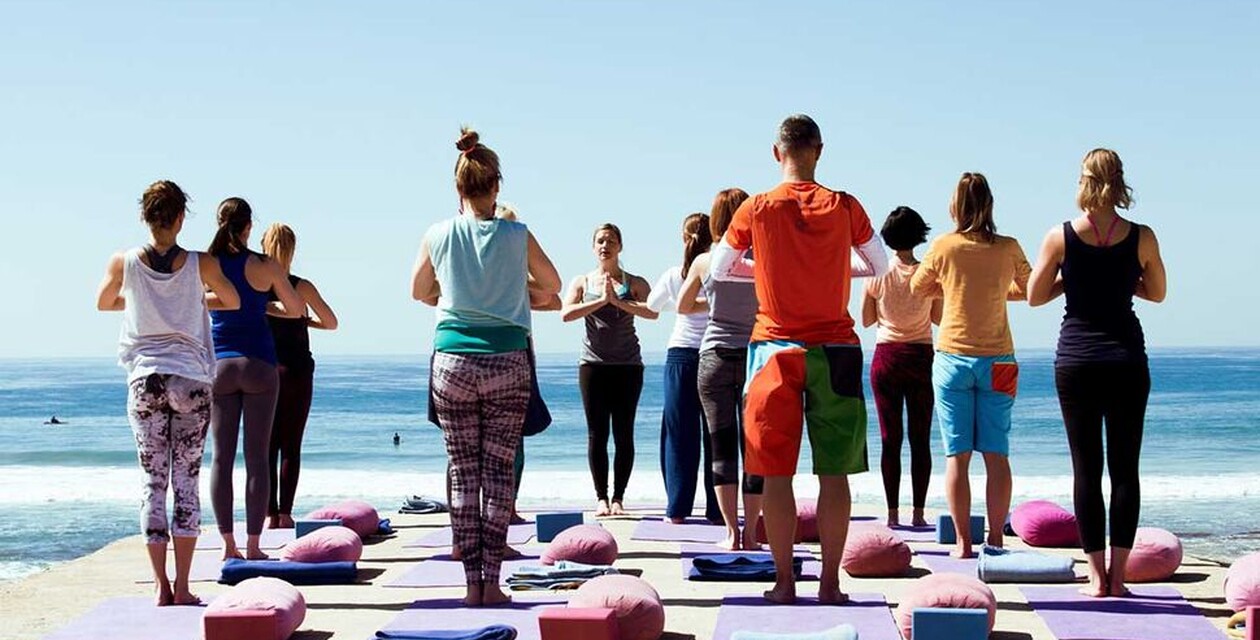
Power Yoga
Power yoga is a dynamic and invigorating style of yoga - as the name suggests: the English term "power" means "strength", "power", "energy", "vigor". In classic power yoga, the teacher leads the students through a vinyasa flow, which is made up of elements from the first series of Ashtanga yoga. The only difference here is that the order of the exercises is flexible.
In contrast to other yoga styles, most power yoga teachers do not use Sanskrit terms. The same applies to mantras and lectures from yoga philosophy. Spirituality is less important in power yoga. It is much more about a new approach to the body. Bryan Kest (born 1964) is considered the inventor of Power Yoga. He sees power yoga as a gentle interpretation of the Ashtanga series, in which a student is allowed to translate the teacher's instructions to suit themselves.
Power yoga summarized:
Modern and young yoga style
Dynamic and invigorating
Focus on movement and the body
. or the body
Especially popular with modern city dwellers
Aim: New approach to the body, strengthening of muscles
Suitable for anyone who loves movement and wants less spirituality
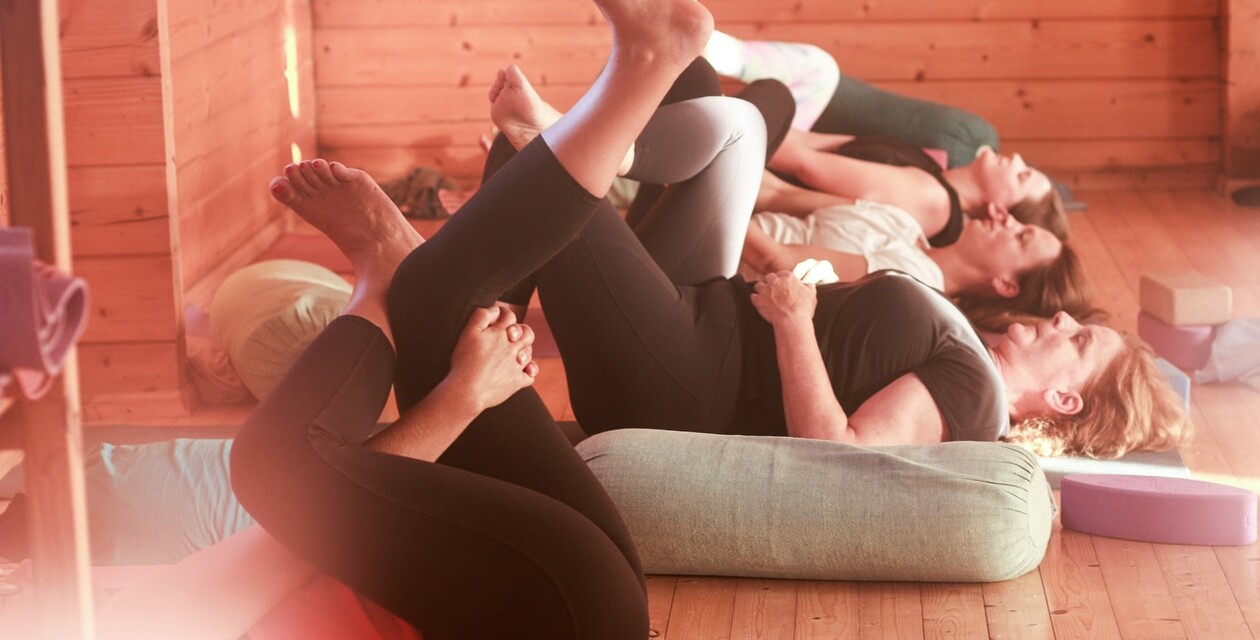
Interview with Bryan Kest - Founder of Power Yoga
Kundalini Yoga
Kundalini yoga is also known as the yoga of energy or consciousness because it aims to awaken and increase life energy (prana or kundalini). Unlike Hatha Yoga, which focuses more on the physical level, Kundalini Yoga focuses on the mental aspects. Kundalini yoga typically involves flowing or dynamic sequences of exercises, combined with mantra meditations and calm holding exercises. The aim is to purify the subtle bodies and harmonize the chakras. The aim is to allow the Kundalini (life energy) to rise upwards.
From royal yoga to mass appeal
Kundalini yoga works with around 50 basic postures such as cobra, triangle, bridge, bow and candle, from which countless other postures and movements are derived.
Kundalini yoga was traditionally passed on from master to student. Kundalini is considered to be the original yoga and was once reserved only for kings, while the people mainly practiced hatha yoga. It was only in the 1960s that Kundalini Yoga was brought to the West and made accessible to the masses.
The 6 components of Kundalini Yoga according to Bhajan
Yogi Bhajan was the first teacher to teach Kundalini Yoga in the West. He came to the United States in 1969 and founded the 3HO association there in the same year. There are 6 components in every Kundalini class according to Yogi Bhajan:
1) Initial Adi mantra ONG NAMO GURU DEV NAMO
2) Pranayama or warm-up
3) Kriyas
4) Relaxation
5) Meditation
6) Closing with the blessing song " May The Long Time Sun Shine Upon You"
Kriyas are complete sets of exercises that are performed in predetermined sequences. These can be simple, short sequences or powerful, even strenuous exercises. They include breathing techniques that strengthen the nervous and endocrine systems.
The breath plays an important role in Kundalini Yoga and should be consciously guided during the practical exercises. Important forms of breathing in Kundalini yoga are fire breath and deep breath.
Kundalini yoga summarized:
Classical yoga style
Aim: Awakening and increasing life energy
The breath is of great importance.
Very spiritual: chanted mantra meditation, blessing song, etc.
Suitable for yoga beginners and advanced practitioners, especially for those who are not just looking for a sporting activity in yoga.
Sivananda Yoga
Sivananda Yoga is based on 5 basic elements: Asanas (physical exercises), Pranayama (breathing techniques), deep relaxation, meditation and nutrition.
It is a holistic system that should be consciously brought to the West. Thus, the Swami Sivananda, who developed this simple system, sent his disciple Swami Vishnudevananda to the West to spread yoga. Sivananda Yoga centers are now spread all over the world and the classes are all structured in the same way. You will experience a well-structured class consisting of pranayama, asanas and relaxation. The centers also offer workshops on nutrition and philosophy and hold regular satsangs. This gives students easy access to the holistic nature of yoga.
The white and yellow secret
If a yoga teacher wears white and yellow clothing, they are most likely teaching Sivananda Yoga. This is because the colors yellow and white form a magical unity here: white stands for oneness with the true self and yellow stands for the eager-to-learn oneness of body, mind and soul. The students only wear white clothing.
Sivananda Yoga summarized
Classical yoga style, based on Hatha Yoga
12 positions from the Rishikesh series as a basis
Spiritual: Asanas, meditation, mantras, pranayama, shavasana, sattvic eating
Large network of ashrams & training centers
Suitable for all yogis who are looking for an interplay of physical and mental well-being and are keen on a holistic approach to yoga.
Friendly for beginners
Niche and special types of yoga
In addition to the widespread and classic styles of yoga, there are numerous niche and specialist types of yoga that focus on specific physical, mental or spiritual needs. These styles often offer a unique approach to yoga and appeal to people who want to try something new or deepen their practice in certain aspects.
Yin Yoga
Ommmmm - now it's time to relax. Yin yoga is a passive, calm and inward-looking form of yoga. In contrast to active yoga styles, which mainly focus on stretching and strengthening the muscles, yin yoga is about opening up the deeper layers of tissue, the connective tissue and fascia. Through slow, conscious stretching, matted, hard fascia becomes supple again, chronic pain subsides and the connective tissue becomes elastic and strong again.
The long postures (3-5 minutes, but also longer) allow us to let go of physical and mental tension, relinquish control and thus enter a mindful, meditative state. This state helps to improve body awareness and achieve physical and mental relaxation.
The first teacher to teach this practice, now known as Yin Yoga, was Paul Grilley, who lives in California with his wife Suzee. He himself was a student of Daoist yoga teacher Pauli Zink, studied meridian theory with Dr. Hiroshi Motoyama and anatomy with Dr. Garry Parker. The influences of these teachers can be felt in Yin Yoga as it is taught today. The meridian progressions of traditional Chinese medicine and the idea of a functional anatomy that is completely individual to each person are repeatedly incorporated into the classes. Incidentally, the name Yin Yoga was given to this practice by Sarah Powers, herself a yoga teacher and one of Paul Grilley's first students.
"We don't use our body to get into a pose, we use the pose to get into our body" Bernie Clark
Yin yoga summarized:
Relaxed, passive, calm
Gentle stretches (held for 3 to 5 minutes)
Aim: Stimulation of fascia, release of tension, physical, emotional and mental balance
Suitable for all levels, especially those looking to de-stress and release tension.
Friendly for beginners
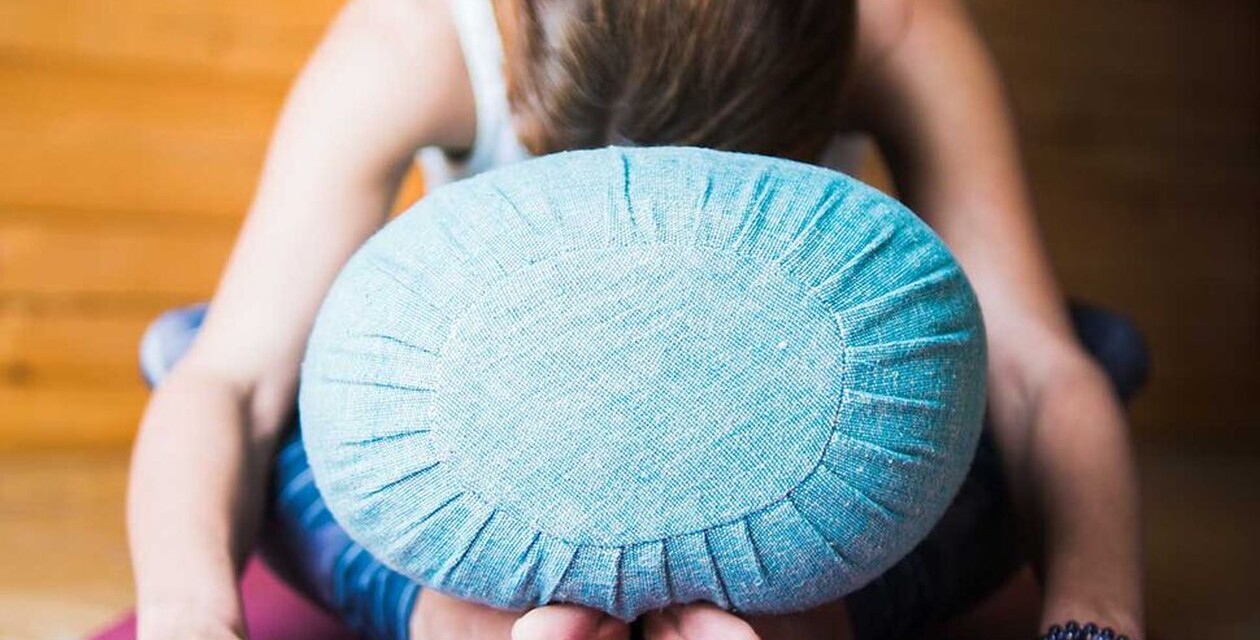
Jivamukti Yoga
Jivamukti yoga is the favorite yoga of stars like Madonna. It was developed in 1984 by Sharon Gannon and David Life. This still very young style of yoga translates the ancient art and science of yoga into today's world in an understandable and pragmatic way. Jivamukti yoga quickly became one of the most successful and popular yoga methods worldwide - especially in the USA.
Gannon and Life studied in India with well-known yogis such as Pattabhi Jois, who is known for developing Ashtanga yoga. For the American couple, yoga is therefore more than a purely physical, athletic practice. Jivamukti yoga is about more, because Jivamukti is a way of life:
The aim of Jivamukti yoga is to impart knowledge about traditional yoga teachings. This includes not only flowing vinyasa yoga sequences but also the study of the most famous scriptures, meditation, music during yoga (anything from classical to electronic) and a harmonious relationship with yourself and the environment. The term is made up of "soul" (jiva) and "liberation" (mukti). The aim is to achieve enlightenment through peaceful coexistence. "Because only those who love others can love themselves," says Sharon Gannon. Animal rights and veganism therefore play a major role in Jivamukti Yoga. However, you don't have to be a vegan to attend the classes. ;-)
Jivamukti Yoga is based on these five pillars
Ahimsa = non-violence, veganism
Bhakti = devotion
Nadam = intense listening within and without (practiced during classes to music)
Shastra = study of classical texts
Dhyana = meditation
Jivamukti Yoga summarized:
Young and modern style combined with tradition
Challenging yoga style
Spiritual: mantras, music, study of classical texts, veganism
Veganism is of course not compulsory to go to yoga classes.
Aim: Spiritual development and liberation; love yourself and others
Suitable for all those who like to challenge themselves and enjoy a mix of tradition and modernity.
Bikram Yoga and Hot Yoga
Watch out, it's about to get hot! Bikram yoga really makes you sweat. 90-40-26 is the magic number combination for this style of yoga: 90 minutes of yoga, 26 exercises and a hot 40 degrees Celcius (did we mention the 40 percent humidity?). Bikram Yogal is named after its founder, Bikram Choudhury, who developed this style after a serious sports injury. He was able to recover from his injury in just six months.
This style of yoga is therefore more about sport and fitness than spirituality. Due to the heat and high humidity, the muscles are very flexible and the asanas are even more effective. Bikram yoga is also easy on the knees and joints. A nice side effect: Bikram yoga is a calorie killer and is ideal for losing weight. This is why Bikram yoga is also the rock star among yoga styles in Hollywood.
Bikram yoga is often referred to as hot yoga, but not all hot yoga is the same as Bikram yoga. This is because Bikram yoga follows the exact order of the 26 exercises:
12 asanas while standing
7 asanas while lying down
7 asanas while sitting or on your knees
2 pranayma (breathing techniques) - also at a specific time
Tip: Bikram yoga is really sweaty. So make sure you have a non-slip yoga mat and the right Bikram yoga clothing.
Bikram yoga in a nutshell:
Hot yoga at 40 C°
Exhausting for the body and circulation (but also healthy :-)
Fewer injuries due to the heat and very joint and knee-friendly
Non-spiritual
Goal: Fitness while protecting muscles and joints
Suitable for: Those looking for fitness instead of yoga philosophy or meditation. Also great for losing weight
Prerequisites: Physical health and fitness should be present

Acro Yoga
When was the last time your world turned upside down and you laughed? Sounds good? Then this style of yoga is for you. Acro yoga aims to be dynamic, fun and varied. This motto works, which is why this style of yoga quickly became very successful. Especially for those who don't know much about meditation and mantra chanting. Acro Yoga is still a very young style of yoga. It was founded in 2004 by Jenny Sauer-Klein and Jason Nemer in San Francisco.
The difference to other yoga styles
Acro Yoga is a combination of classical yoga exercises, acrobatics and the classic NUAD Thai massage. The most important difference to the other yoga styles: You have to be at least two people to do it. Trust, give and take and the contrast between strength and gentleness play a central role in acro yoga.
Acro yoga summarized
Young style
Happy, dynamic
Mix of yoga & acrobatics
You should be at least two people.
Less spiritual: no mantras, pranayamas etc.
Aim: movement, body tension, confidence
Suitable for anyone who wants to do it
For beginners in acroyoga: the front bird
An important exercise in acroyoga is the front bird, the dynamic or therapeutic flying. This is also the exercise that beginners learn first. You can try it out for yourself at home with this video. And if you like it, grab your best friend or your partner and go to acroyoga. :-)

Entry position "Front Bird" (flyer)
Anusara Yoga
Anusara is a life-affirming and heart-opening yoga practice.
The word "Anusara" comes from Sanskrit and loosely translates as "flowing with grace" or "following the heart". Instead of fitting into an external, predetermined form, the aim is to find and feel the alignment of the asanas from within.
The five universal principles of alignment (UPAs), which are based on modern bio-mechanical findings, are used for this. The five principles are
Open to Grace
Muscular Energy
Inner Spiral
Outer Spiral
Organic Energy.
They are used in all hours and help to achieve an anatomically healthy posture, which ensures a free flow of energy in the body.
Each Anusara class is dedicated to a philosophical theme from the heart. This theme forms the focus of the class and is interwoven with the asanas. For example, the theme of trust can be the focus of the class and can be taken up again and again in the asana practice through trust in one's own abilities, in the wisdom of one's own body or in one's own balance.
The tantric philosophy on which Anusara yoga is based sees every person as perfect and this perfection is expressed in the open, wide and radiant asanas.
Anusara yoga summarized:
Young yoga style from the USA
Based on 5 alignment principles
Each class is dedicated to a heart theme.
Aims: Better energy flow in the body, more joie de vivre & well-being
Suitable for beginners

Yoga Nidra
Less of energy? Then try this style of yoga. Yoga nidra, literally translated as "yogic sleep", is a guided meditation that is practised while lying down. You are in a completely relaxed state, somewhere between waking and sleeping. You train your awareness of your body, your thoughts and ultimately your emotions.
You work your way from layer to layer, so to speak. In yoga philosophy, it is assumed that human energy manifests itself from the gross material (the physical body) to the subtle (astral body). Yoga Nidra exercises are designed to reach deeper layers of consciousness and promote an attitude of benevolent openness towards yourself and life, as well as to recharge your batteries - as if you had just been asleep. With Yoga Nidra, you can virtually replace the power nap ;-)
Yoga Nidra in a nutshell:
Meditation that leads to deep relaxation
Conscious awareness of the body and emotions
Goal: More life energy and a positive attitude towards yourself
Suitable for anyone looking for more life energy
Karma Yoga
Would you like to be happier, more balanced and more self-confident? Great, because that's exactly what you can achieve with Karma Yoga. There's no yoga mat or sweaty asanas here. You can practise karma yoga all day and everywhere.
Karma yoga is an ancient yoga tradition from India and translates as "yoga of action". This yoga style is part of the six paths of integral yoga and is the term for non-attached action and selfless service. Karma yoga aims to reduce karma and thus create access to higher consciousness. All unfinished karma is a burden that prevents you from accessing the superconscious. This is exactly where karma yoga comes in. It is about freeing yourself from old baggage and opening yourself up to new possibilities. In karma yoga, we talk about these three types of karma:
Sanchita - Work and actions that have accumulated
Prarabdha - Fake work and actions of the past
Krivamana/Agami - Current deeds and work
In karma yoga, you should therefore learn how to free yourself from old ways of thinking and acting. Competition, hostility, envy, bullying, revenge, selfish striving for success should no longer find a place in your actions and ways of thinking. Because striving for (unattainable) goals frustrates you and makes you unhappy.
It's not easy to let go of all this. And as always in yoga, karma yoga does not require you to radically change yourself. In this yoga style, too, everyone should go as far as is good for them
Karma yoga summarized:
An old yoga style from India (Hinduism)
No physical exercises
Removal of old baggage (bad karma), development of new patterns of action
Aim: Strengthening inner balance and self-esteem, new perspectives
Suitable for anyone who is stuck in a dead end or feels burnt out and wants to free themselves from old habits.
Prenatal Yoga
Prenatal yoga is specially tailored to the needs of expectant mothers. It promotes physical strengthening, especially of the back and pelvic floor, and prepares the body for birth. At the same time, breathing techniques and relaxation exercises are taught, which can be helpful during pregnancy and birth. Prenatal yoga is a gentle but effective practice that aims to promote the mother's well-being and reduce stress.
Restorative Yoga
Restorative yoga aims for complete relaxation and regeneration. In contrast to more dynamic styles, the poses here are supported with the help of aids such as blankets, blocks and straps so that the body can relax completely. The poses are held for a long time and in complete stillness, which helps the nervous system to calm down and reduce stress. Restorative yoga is ideal for people looking for a particularly gentle yoga practice, whether to recover from injury or to promote deep relaxation.
Aerial Yoga
Aerial yoga is an innovative form of yoga in which poses are performed using cloths or hammocks suspended from the ceiling. This allows participants to hold certain positions in the air or float, which reduces gravity and facilitates complex stretches. Aerial yoga improves balance, strengthens muscles and offers a feeling of weightlessness. It is ideal for people looking for the challenge and fun of an airborne practice.
Modern trends in yoga
In recent years, new and creative types of yoga have developed that adapt to the needs of our modern society. These innovative trends expand the classic practice and offer exciting opportunities to integrate yoga into everyday life and appeal to new target groups.
Face Yoga
Face yoga is a growing trend that uses targeted exercises to strengthen and relax the facial muscles. Similar to traditional yoga, which exercises the entire body, face yoga aims to tone the muscles in the face, prevent wrinkles and revitalize the skin. The exercises often include stretching, massage techniques and conscious breath work to release tension and promote circulation. Face yoga is increasingly seen as a natural way to strengthen facial features and make them look more youthful without invasive beauty treatments.
Yoga for seniors
Yoga for seniors is a specially adapted form of yoga that takes into account the physical challenges of ageing. The movements are gentler, with a focus on improving flexibility, balance and strength. Aids such as chairs, blocks or blankets are often used to make the exercises safer and more accessible. This type of yoga is ideal for older people as it can reduce the risk of falls, improve joint mobility and increase overall wellbeing. Yoga for seniors also offers mental benefits by promoting mindfulness and relaxation.
SUP Yoga (Stand-Up Paddle Yoga)
Fancy a new challenge? Swap your yoga mat for a surfboard and try something new. SUP yoga is perfect in summer as it is practiced on the water. SUP stands for Stand Up Paddling. SUP involves paddling while standing on a special board. But paddling alone is boring, so now there's SUP yoga. Depending on the waves, it can be quite challenging. Beginners should try SUP yoga on a calm lake first.
SUP yoga is a great way to train your inner and physical balance, as you not only have to hold yourself in the asanas but also on the board. A SUP yoga class basically runs like a normal yoga class: Meditation, asanas and shavasanas... everything is possible. The exercises are more intense on the SUP board than on land, as concentration and body tension are even more crucial here.
SUP yoga is also about relaxation. You're basically practising on your own little island. It always feels a bit like being on vacation. ;-)
SUP yoga in a nutshell
Trendy yoga style, ideal for summer
Yoga exercises on the stand up paddling board (on the water)
Aim: Concentration, body tension, relaxation
Suitable for anyone who would like to try yoga on the water
Tip: You can borrow a SUP from us at the camp and practise a little. Instead of normal yoga clothing, we recommend swimwear. Of course, you can also wear normal yoga clothing. Don't forget sunscreen!
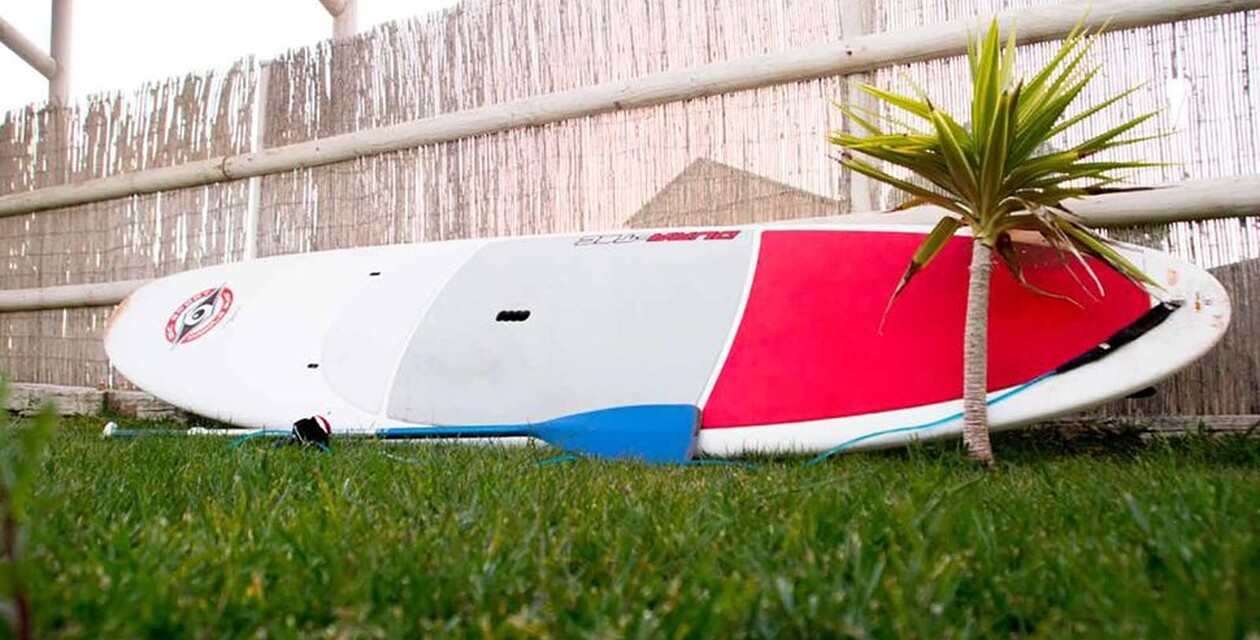
How do I find the right yoga style for me?
The variety of yoga styles can be overwhelming, but with a clear idea of your goals, fitness level and health status, you can find the style of yoga that suits you best. Here's a guide to help you choose:
How to find your yoga style
1. Define your goals
Stress reduction and relaxation: If you want to use yoga for relaxation and stress reduction, Yin Yoga, Restorative Yoga or Hatha Yoga are recommended. These styles promote calm and mindfulness through slow movements and prolonged posture holding.
Strength and fitness: If you are looking for a physically demanding workout, Vinyasa Yoga, Ashtanga Yoga or Power Yoga could be the right types of yoga for you. They improve strength, endurance and flexibility through dynamic and flowing movements.
Spiritual development: If you are more interested in the meditative and spiritual aspects, Kundalini Yoga or Jivamukti Yoga are suitable options. They integrate mantras, meditation and breathing techniques to expand your awareness.
Flexibility and balance: Iyengar Yoga or Aerial Yoga can help improve your posture and strengthen your sense of balance by focusing on precise alignment and tools.
2. Consider your fitness level
Beginners:
Hatha Yoga: Ideal for learning the basic asanas (postures) and pranayama (breathing techniques). It offers a moderate pace and enables a deep understanding of yoga basics.
Iyengar Yoga: Perfect for beginners who value correct alignment. Asanas can be learned safely through the use of aids.
Restorative yoga: Well suited to slowly getting into the yoga practice and finding relaxation at the same time.
Advanced:
Ashtanga Yoga: Offers an intensive and structured practice with set series, ideal for those looking for a challenge.
Power Yoga: A dynamic and powerful style that focuses on fitness and integrates elements of Ashtanga.
AcroYoga: Combines acrobatics and yoga, encourages partner work and is ideal for those who enjoy social interaction and new challenges.
3. Pay attention to your health
Injuries or physical limitations: Iyengar Yoga and Yin Yoga are recommended as they utilize adjustments and tools to practice safely. Always consult a doctor or qualified yoga teacher before you start.
Pregnancy: Prenatal Yoga is specifically tailored to the needs of expectant mothers. It helps to strengthen the body and prepare it for birth.
Stress and mental health: Kundalini Yoga and Restorative Yoga can help to reduce stress and promote emotional well-being.
4. Try out different types of yoga
It can be helpful to try out different types of yoga to find out which style suits you best. Many studios offer trial classes or beginners' courses. Pay attention to how you feel during and after the practice.
5. Consider the teacher's teaching style
The teacher plays a crucial role in your yoga experience. Some teachers place more emphasis on the physical execution, while others emphasize the spiritual aspect. Find a teacher whose style and philosophy align with your goals.
Overview of recommendations
For relaxation and stress reduction: Yin yoga, restorative yoga, hatha yoga
For physical fitness and endurance: Vinyasa Yoga, Ashtanga Yoga, Power Yoga
For spiritual practice: Kundalini Yoga, Jivamukti Yoga
For special needs:
Pregnant women: Prenatal yoga
Elderly people: Yoga for seniors
Rehabilitation: Iyengar Yoga, Therapeutic Yoga
Conclusion
The right choice among the many types of yoga depends on your individual needs and preferences. Take time to reflect on your goals and be open to trying new things. Remember that yoga is a personal path that can change over time. The most important thing is to find a style that brings you joy and enriches you on a physical and mental level.
The health benefits of yoga
Yoga offers a variety of physical and mental benefits that make it one of the most popular wellness practices worldwide. Whether you are a beginner or an advanced practitioner, practicing yoga regularly can lead to significant improvements in wellbeing.
Advantages
Physical benefits
Flexibility: One of the most obvious benefits of yoga is the improvement in flexibility. The regular practice of asanas (postures) helps to stretch the muscles and connective tissue, which leads to greater freedom of movement. This has a positive effect on overall mobility and joint health.
Muscle strengthening: Yoga not only strengthens the large muscle groups, but also deep-lying muscles that are often neglected. Asanas such as Plank or Warrior 2 promote muscle building without the need for heavy weights. This is particularly useful for people who want to build up their strength in a gentle and sustainable way.
Improving posture: A regular yoga practice can significantly improve posture. Targeted training of the core and back muscles aligns the body and promotes upright postures. This can help prevent back pain, which is often caused by poor posture or prolonged sitting.
Mental benefits
Stress reduction: One of the main aims of yoga is to promote relaxation and inner calm. Breathing techniques (pranayama) and meditation, which are often integrated into yoga practices, help to calm the mind and reduce stress. Numerous studies show that regular yoga can lower levels of the stress hormone cortisol.
Improved concentration: Yoga improves the ability to concentrate and stay focused. The mindfulness practiced during yoga sessions promotes mental clarity and helps to minimize distractions.
Promoting inner calm: In addition to stress management, yoga promotes a deep sense of inner calm. This is due to the combination of movement, breathing and meditation, which calms the nervous system and promotes emotional stability.
Yoga as a form of therapy
Yoga is increasingly being used as a supportive form of therapy for a variety of health complaints. It can help to promote the healing process and alleviate chronic conditions.
Rehabilitation after injury: Through gentle and controlled movements, yoga is ideal for people in rehabilitation after injury. The practice can help restore mobility and rebuild muscles after prolonged periods of rest.
Support for chronic conditions: Studies show that yoga can be an effective adjunct in the treatment of chronic conditions such as back pain, arthritis and even heart disease. It promotes circulation, reduces pain and can relieve inflammation.
Yoga and the modern way of life
In a hectic world where stress and time pressure are omnipresent, yoga can be a valuable practice for integrating balance and mindfulness into everyday life. Even with a busy schedule, yoga can be easily incorporated into your daily routine.
How yoga fits into your everyday life
Integration into hectic everyday life
Yoga can be perfectly adapted to the needs of a modern lifestyle. Even when the daily routine is busy, short yoga routines offer a way to relax and refresh body and mind.
Recommendations for short yoga routines at home or in the office
You can incorporate yoga exercises that reduce stress and promote flexibility even in short time slots of 10 to 20 minutes:
Morning routine: A few sun salutations (Surya Namaskar) directly after getting up can get the circulation going and get the day off to an energetic start.
Office break yoga: Simple stretching exercises and breathing techniques such as the shoulder stretch or cat-cow pose (Marjaryasana-Bitilasana) help to relieve tension in the back and neck caused by prolonged sitting.
Yoga apps and videos for daily practice
Thanks to digitalization, there are a multitude of yoga apps and online platforms that integrate yoga into everyday life. They offer programs for every level, from beginner to advanced, and can be used flexibly at home or on the go. Popular apps such as Yoga with Adriene, Asana Rebel or Glo offer guided yoga classes that can be adapted to different needs and schedules.
Small yoga lexicon
In this mini yoga lexicon, we briefly explain the terms we have used in the text. You will come across them again and again in your yoga practice. It is therefore very useful to know these terms.
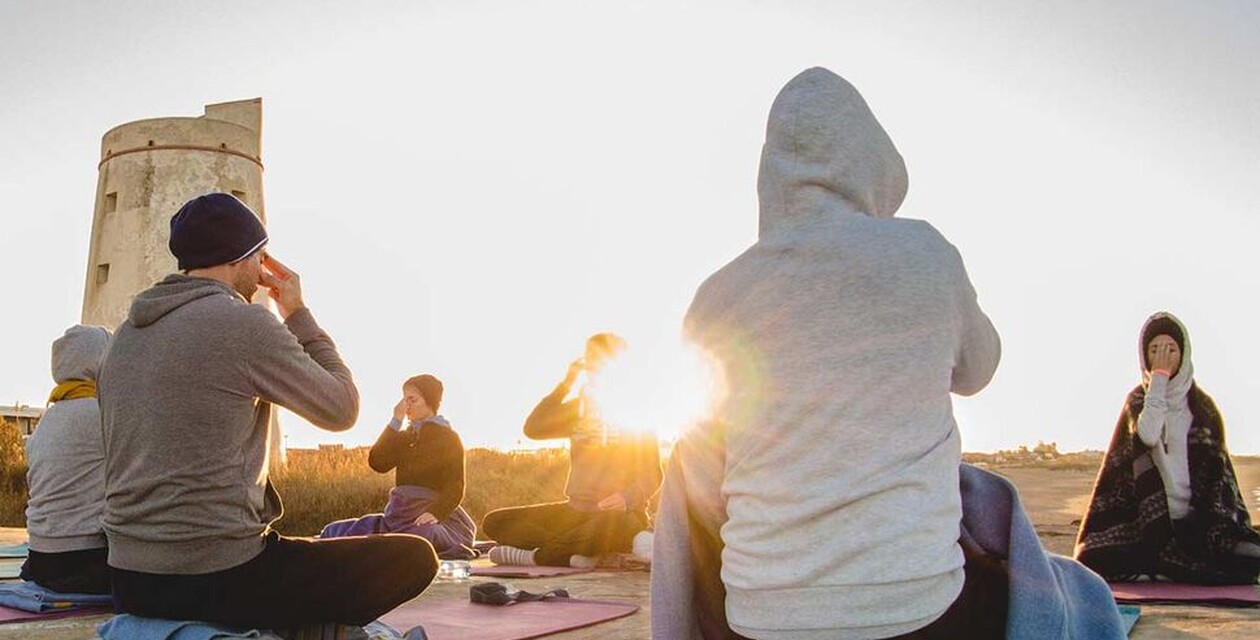
Lexicon
Asanas
This is what the individual yoga postures, i.e. physical positions, are called in Sanskrit.
Pranayama
Pranayama is the yogic breath. These are breathing exercises that direct and control the breath. Pranayamas have an activating or calming effect on the nervous system, especially on the sympathetic and parasympathetic nervous systems. The breathing exercises also help to set the energy flow in motion. In tantric yoga philosophy, it is the other way around. The assumption is that you cannot control your breath. The idea here is to expand the breath in order to obtain more vital energy.
A disturbed breath leads to a disturbed consciousness, a regular breath leads to a calm consciousness. The two go hand in hand. This is why yogis value a regular and calm breath - in this way, they control their consciousness and thus prolong their lives.
Hatha Yoga Pradipika
Ujjayi breathing
In yoga, special attention is paid to controlling the breath. Ujjayi breathing is used in dynamic yoga in particular. Translated, Ujjayi means victorious or aspiring. The breath is directed from the natural abdominal breathing into the chest. This breathing exercise is designed to help you gain more energy and improve your breathing ability. During Ujjayi breathing, the constriction of the glottis creates a hissing sound - many describe it as sea smoke. The breath becomes longer and audible, allowing you to breathe more consciously during your asana practice.
Shavasana
You have probably already experienced Shavasana in a yoga class as a final relaxation at the end of a yoga class. Literally translated, Shavasana means the dead pose. This position looks easy at first because you are just lying there. But Shavasana is actually one of the most difficult exercises. This is because you come to rest after a yoga class and your thoughts are usually spinning. This is precisely why this yoga exercise is usually performed at the end of a yoga class. After the activity, the body is somewhat tired and it is easier for the mind to relax. At the same time, however, this is precisely the challenge. Because as soon as the body is calm, you can hear the mind particularly loudly.
Shavasana is used to reflect again at the end of a yoga practice. Incidentally, you should not fall asleep during Shavasana, but rather be in a relaxed, awake state and reflect on the practice. In other words, let go mentally and physically. If you do fall asleep, then your body simply needs it and that's just the way it is ;)
Shavasana is usually at least 10 minutes long. However, there are yoga styles where Shavasana is longer or shorter. Depending on whether you want to leave the yoga class activated or calm. In the already calm Yin yoga, for example, you don't do such long Shavasanas.
Chakra
Chakras are the energy centers in the body. If one of the chakras is blocked, the energy in the body can no longer flow properly. It is therefore good to clear these blockages. The chakras affect the whole person. There are these seven main chakras:
Root chakra (base chakra) → Meaning: Connection to the earthly, life force, success, survival
Sacral chakra → Meaning: Physical emotion, lust for life, creative power, sexuality
Solar plexus chakra (solar plexus) → Meaning: thoughts, intellect, subconscious
Heart chakra → Meaning: Higher love, devotion, compassion
Collar chakra (throat chakra) → Meaning: communication, wisdom, individuality
Forehead chakra (third eye) → Meaning: Opening to and expression of the soul
Crown chakra (crown chakra) → Meaning: divine purpose and connection for our soul and body
Mantra
A mantra is a sacred verse or sound and is usually chanted. Mantras are "magical" words that are meant to open the heart. In Ashtanga yoga, the yoga practice usually begins with a mantra. Om is the most famous and also the shortest mantra in yoga. It is described as a primordial sound whose vibrations connect everyone and everything. Om therefore gives you a feeling of unity.
But there are countless other mantras that symbolize the spiritual background of yoga. Mantras can also be modern. For example, mantra singer and songwriter Janin has released an entire album. The mantra music by yoga teacher and artist Julia Elena
Mudra
Mudras are symbolic gestures used to direct energy. The term comes from Sanskrit and means seal.
The best-known mudras, which are also used in yoga practice, are those performed with the hands and fingers. The hand and finger gestures stimulate points that are connected to the meridians and energy pathways of our body and thus get the energy flowing. Mudras should always be practiced with relaxed hands and only light pressure. However, there are also eye mudras, tongue mudras and bandhas, which also serve to control and concentrate energy. The most well-known include Anjali Mudra, Chin Mudra and Vishnu Mudra.
Book tip: Mudras - Finger Yoga for Health, Vitality and Inner Peace - by Gertrud Hirschi. In this volume, the Swiss yoga teacher presents a wealth of mudras that promote your own physical and mental well-being, tackle health problems and bring inner peace and balance
Conclusion: the types of yoga
Yoga is much more than just a physical practice - it is a holistic lifestyle that brings both body and mind into harmony. The wide variety of types of yoga makes it possible for everyone to find a suitable practice, regardless of fitness level or life situation. Whether you want to strengthen your body, improve your flexibility or promote inner peace - there is a suitable style for every need.
It's worth trying out different styles of yoga to find out which one suits you and your goals best. Be open to new experiences and see yoga as an ongoing path of personal development where you can experience both physical and mental strengthening. Your own yoga path is unique - enjoy the journey and the positive changes it brings to your life!

Fancy yoga by the sea?
If you're now in the mood for yoga, take a look at our yoga retreats. You're sure to find something suitable. We teach in our own yoga house with a view of the Atlantic. With us, you can do yoga, learn to surf or combine the two. In addition to the yoga retreats, we also offer open yoga classes for spontaneous yogis. Maybe we'll see you in Spain soon!